Posted by PuertoMadero in asides, Blog, Featured Articles | 3 Comments
COMETA ISON -TORMENTA SOLAR, Aporte Hno. P.López
Envío enlace acerca del ISON, habla de la aparición de una segunda cola en el cometa a menos de tres semanas de que se acerque al sol.
A continuación un enlace con la imágen del ISON y la nueva cola y en el segundo enlace el texto del artículo. El texto está en inglés.
http://d1jqu7g1y74ds1.cloudfront.net/wp-content/uploads/2013/11/Ison-Damian-Nov6-580×361.jpg
(Hay que aclarar que si bien ésto es muy poco usual, recientemente también se ha descubierto un cometa con 6 colas)
http://www.universetoday.com/106205/comet-ison-heats-up-grows-new-tail/
INFORMACION EN INGLES:
.
Comet ISON Heats Up, Grows New Tail
by BOB KING on NOVEMBER 7, 2013
Want to stay on top of all the space news? Follow @universetoday on Twitter
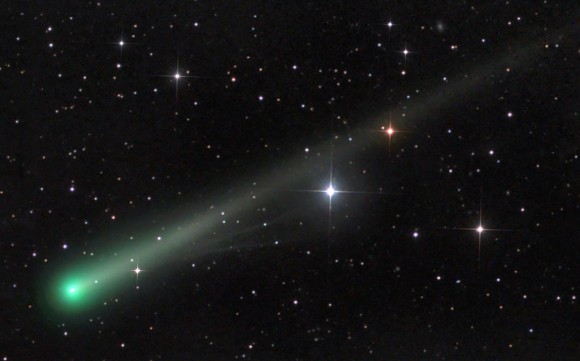
I’m starting to get the chills about Comet ISON. I can’t help it. With practically every telescope turned the comet’s way fewer than three short weeks before perihelion, every week brings new images and developments. The latest pictures show a brand new tail feature emerging from the comet’s bulbous coma. For months, amateur and professional astronomers alike have watched ISON’s slowly growing dust tail that now stretches nearly half a degree or a full moon’s diameter. In the past two days, photos taken by amateur astronomers reveal what appears to be a nascent ion or gas tail. Damian Peach’s Nov. 6 image clearly shows two spindly streamers.


Ion tails are composed of gases like carbon monoxide and carbon dioxide blown into a narrow straight tail by the solar wind and electrified to fluorescence by the sun’s ultraviolet light. Being made of ions (charged particles), they interact with the sun’s wind of charged particles. Changes in the intensity and direction of the magnetic field associated with sun’s exhalations kink and twist ion tails into strange shapes. Strong particle blasts can even snap off an ion tail. Not that a comet could care. Like a lizard, it grows a new one back a day or three later.
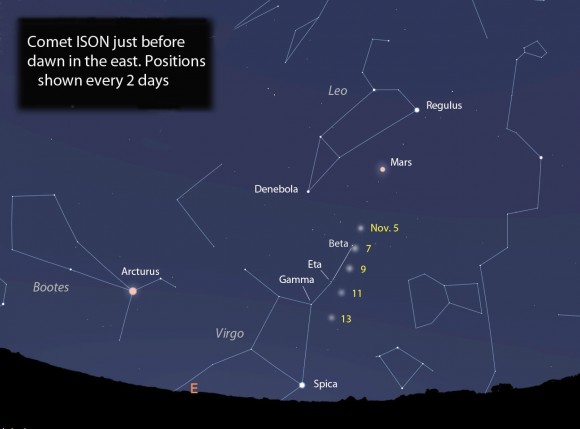
A fresh forked tail isn’t ISON’s only new adornment. Its inner coma, location of the bright “false nucleus”, is becoming more compact, and the overall magnitude of the comet has been slowly but steadily rising. Two mornings ago I pointed a pair of 10×50 binoculars ISON’s way and was surprised to see it glowing at magnitude 8.5. Things happen quickly now that the comet is picking up speed While it appeared as little more than a small smudge, any comet crossing into binocular territory is cause for excitement. Other observers are reporting magnitudes as bright as 8.0. Estimates may vary among observers, but the trend is up. Seiichi Yoshida’s excellent Weekly Information about Bright Comets site predicts another half magnitude brightening over the next few days. You can use the map here to spot it in your own glass before the moon returns to the morning sky.

But wait, there’s more. Emmanuel Jehin, a member of the TRAPPIST ( TRAnsiting Planets and PlanetesImals in Small Telescopes) team, a group of astronomers dedicated to the detection of exoplanets and the study of comets and other small solar system bodies, reports a rapid rise in ISON’s gas production rate in the past several days. They’ve increased by a factor of two since Nov. 3. Could the spike be connected to the development of an ion tail? Jehin and team have also recorded two active jets coming from the comet’s nucleus using specialized filters. Dust production rates however have remained flat.
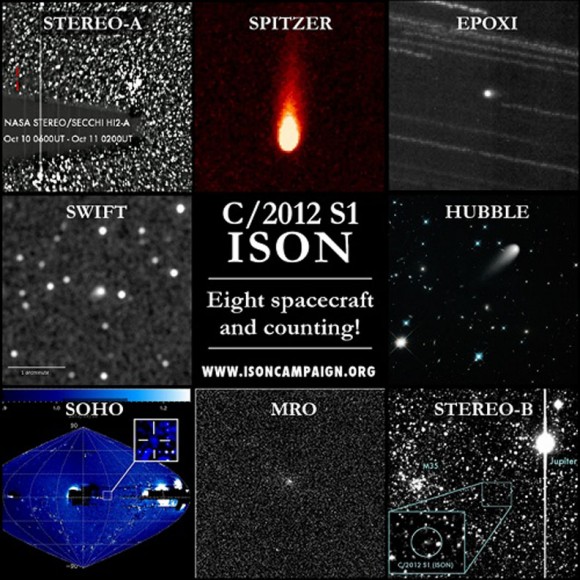
Casey Lisse of the Comet ISON Observing campaign (CIOC) reports that the Chandra X-ray Observatory just became the 9th spacecraft to image the comet . More details and photos should be available soon. The campaign predicts the comet will peak in brightness between -3 to -5 magnitude when it zips closest to the sun on Nov. 28. Want to ride alongside the comet during its passage through the inner solar system? Click on this awesome, interactive simulator.
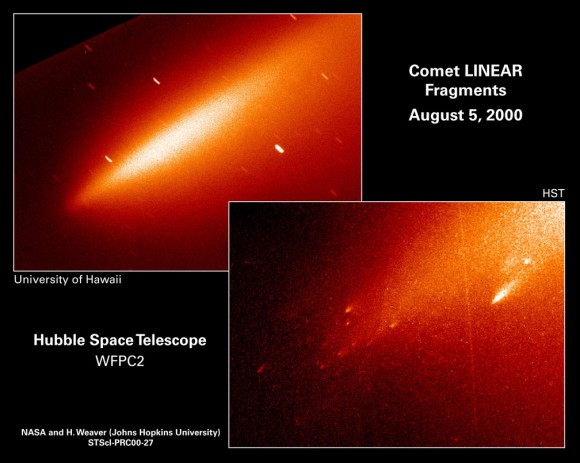
Because ISON is a fresh-faced visitor from the distant Oort Cloud that will soon face the full fury of the sun, speculation of its fate has ranged across the spectrum. Everything from breakup and dissolution before perihelion to surviving intact trailing a spectacular dust tail. The comet is currently approaching the 0.8 A.U. mark (74.4 million miles / 120 million km) when previous comets C/1999 S4 LINEAR in 2000 and C/2010 X1 Elenin in 2011 crumbled to pieces and vaporized away. Will ISON have the internal strength to pass the test and venture further into the solar boil? Should it survive, it faces a formidable foe – the sun. Both the intense solar heat and gravitational stress on the comet’s nucleus could easily tear it apart. If this happens a few days before perihelion we’ll be left with little to see, but if ISON busts up a day or two after perihelion, watch out baby. When the comet reappears in the morning sky, it may be missing its head but make it up for the loss with a spectacular tail of fresh dust and ice many degrees in length. This is exactly what happened to Comet C/2011 W3 (Lovejoy) in December 2011. After its close graze with the home star, the nucleus disintegrated, producing a striking tail seen by skywatchers in the southern hemisphere.
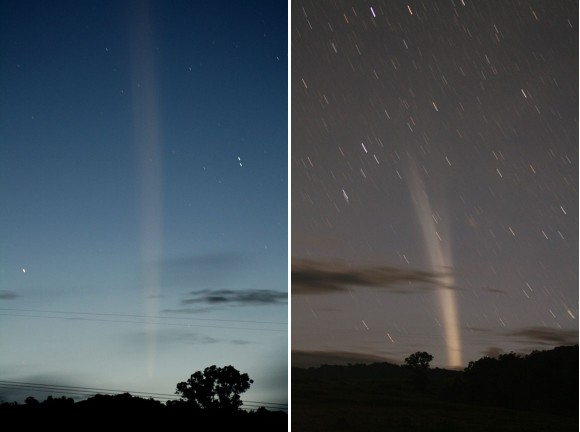
The final scenario sees Comet ISON pushing past all barriers intact and ready to put on a splendid show. Whatever happens, I suspect we’re in for surprises ahead. For a more detailed analysis of these possibilities I invite you check out Matthew Knight’s blog on the CIOC website.
Read more: http://www.universetoday.com/106205/comet-ison-heats-up-grows-new-tail/#ixzz2kDDeW4aR
I’m starting to get the chills about Comet ISON. I can’t help it. With practically every telescope turned the comet’s way fewer than three short weeks before perihelion, every week brings new images and developments. The latest pictures show a brand new tail feature emerging from the comet’s bulbous coma. For months, amateur and professional astronomers alike have watched ISON’s slowly growing dust tail that now stretches nearly half a degree or a full moon’s diameter. In the past two days, photos taken by amateur astronomers reveal what appears to be a nascent ion or gas tail. Damian Peach’s Nov. 6 image clearly shows two spindly streamers.
.
Estoy empezando a tener escalofríos sobre el Cometa ISON . No puedo evitarlo. Con prácticamente todos los telescopios pendientes de la trayectoria del cometa a menos de tres cortas semanas antes del acercamiento al sol (perihelio), cada semana nos traen nuevas imágenes y avances. Las últimas imágenes muestran una nueva característica cola que emergente de la coma del bulbo del cometa. Durante meses , los astrónomos aficionados y profesionales han visto crecer lentamente la cola de polvo del ISON que ahora se extiende a casi medio grado o diámetro de la luna llena. En los últimos dos días , las fotos tomadas por astrónomos aficionados revelan lo que parece ser una creciente cola de gas o iones . La imagen de Damian Peach 06 de noviembre muestra claramente dos serpentinas delgadas .
LAs colas de iones están compuestos por gases como el monóxido de carbono y dióxido de carbono quemado en una cola recta estrecha por el viento solar y electrificado hasta resultar fluorescente con la luz ultravioleta del sol. Al estar hecha de iones (partículas cargadas) ,interactúan con las partículas cargadas del viento solar . Los cambios en la intensidad y dirección del campo magnético asociadas con exhalaciones de sol se tuercen dando lugar a colas de iones en formas extrañas . Explosiones de partículas sólidas pueden incluso romper una cola de iones .No es que al cometa le importe . Al igual que una lagartija , le crecerá una nueva cola tras unos días.
TORMENTA SOLAR
.
TORMENTA SOLAR
noviembre 09, 2013
ALERTA: PROBABILIDAD DE FUERTES LLAMARADAS DIRIGIDAS A LA TIERRA
Mancha solar 1890 sigue frente a la Tierra cada vez más grande y retiene una configuración capaz de producir las más fuertes llamaradas solares.
MANCHAS SOLARES 09 DE NOVIEMBRE 2013
La región activa produjo una llamarada solar X1.1 impulsiva a las 04:26 UTC, el viernes.
Se observó una eyección de masa coronal (CME) y se observó un componente menor dirigido a Tierra.
Un impacto de refilón será posible antes del 11 de noviembre, según el modelo más reciente CME publicado por Goddard.
La región activa estará en una posición perfecta geoeffective durante los próximos 3 días, y es probable que las futuras erupciones serían dirigidas a la tierra.
Mancha solar 1891 sigue poseyendo una configuración delta débil y produce una llamarada solar M2.3 a las 09:28 UTC viernes por la mañana.
Una nueva mancha solar gira a la vista de la extremidad este y se numerarán 1893 hoy. Parece ser estable con un diseño magnético sencilla. Seguirá existiendo una oportunidad para otra moderada a fuerte aislado llamarada solar dentro de las próximas 24 horas con 1890 siendo la fuente más probable.
http://tormenta-solar.blogspot.com.es/2013/11/alerta-probabilidad-llamaradas-solares-a-tierra.html
NOTAS:
TORMENTA SOLAR
Qué es una tormenta solar?
¿Qué es una tormenta solar o tormenta geomagnética y cómo puede afectarnos?
Según definiciones de la Aeronáutica Nacional y Administración Espacial, National Aeronautics and Space Administration, por sus siglas en inglés, NASA, se dice que:
Llamarada Solar. Es una rápida liberación de energía de una región específica en el Sol en la forma de radiación electromagnética, partículas energéticas y movimientos de masa.
Radiación Electromagnética. Es una radiación que viaja por el espacio a la velocidad de la luz y se propaga por la interacción de campos eléctricos y magnéticos oscilantes.
Las áreas en el hemisferio Norte son las más susceptibles de verse afectadas dada su cercanía al Polo Norte, el cual tiende a atraer gran parte de la energía que llega a la tierra. De hecho las llamaradas solares causan espectaculares auroras boreales.
Pero con la globalización e intercomunicación de sistemas a nivel mundial y el uso internacional y compartido de satélites y sistemas internacionales, que pudieran verse afectados por estas “tormentas” solares, todos probablemente estamos expuestos a sentir sus efectos o consecuencias en los próximos años.
El incremento en la cantidad de satélites orbitando la tierra y la interconexión de sistemas de distribución de energía eléctrica, telecomunicaciones y transmisión de señales de televisión, radio, video, audio y datos en los cuales la sociedad actual depende para su desenvolvimiento diario crean el escenario para un mayor impacto en nuestras vidas de estas poco conocidas tormentas o llamaradas solares.
TIPOS DE LLAMARADAS
Las erupciones solares se clasifican como A, B, C, M o X dependiendo del pico de flujo de rayos X (en vatios por metro cuadrado, W/m2) de 100 a 800 picómetros en las inmediaciones de la Tierra, medidos en la nave GOES.
Cada clase tiene un pico de flujo diez veces mayor que la anterior, teniendo las erupciones de clase X un pico del orden de 10-4 W/m2. Dentro de una clase hay una escala lineal de 1 a 9, así que una erupción X2 tiene dos veces la potencia de una X1, y es cuatro veces más potente que una M5. Las clases más potentes, M y X, están asociadas a menudo con varios efectos en el entorno espacial cercano a la Tierra. Aunque se suele usar la clasificación GOES para indicar el tamaño de una erupción, es sólo una medición.
Saludos,
P.López

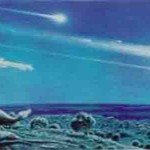




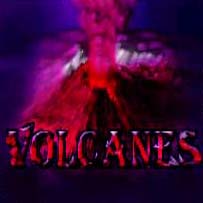
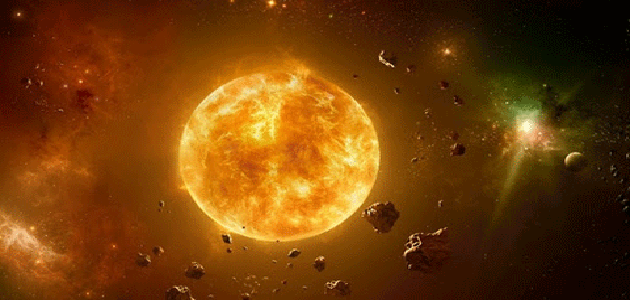












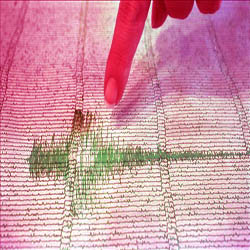
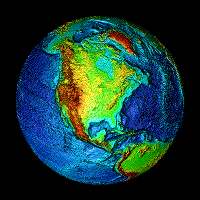













El cometa ISON sufre un estallido y ya es visible a simple vista
http://www.lavanguardia.com/ciencia/20131115/54393472093/cometa-ison-estallido-visible.html
La llegada de las Cuatro Lunas Rojas de Sangre 2014 – 2015
Las lunas de sangre tiene que ver con Israel..
http://www.youtube.com/watch?feature=player_detailpage&v=QL_h1oBCcYc
ESTA PAGINA ES SOLO PARA CREYENTES CRISTIANOS APERCIBIDOS QUE AMAN AL SEÑOR JESUS Y ESPERAN SU VENIDA
http://www.lavozeneldesierto.org/1.html